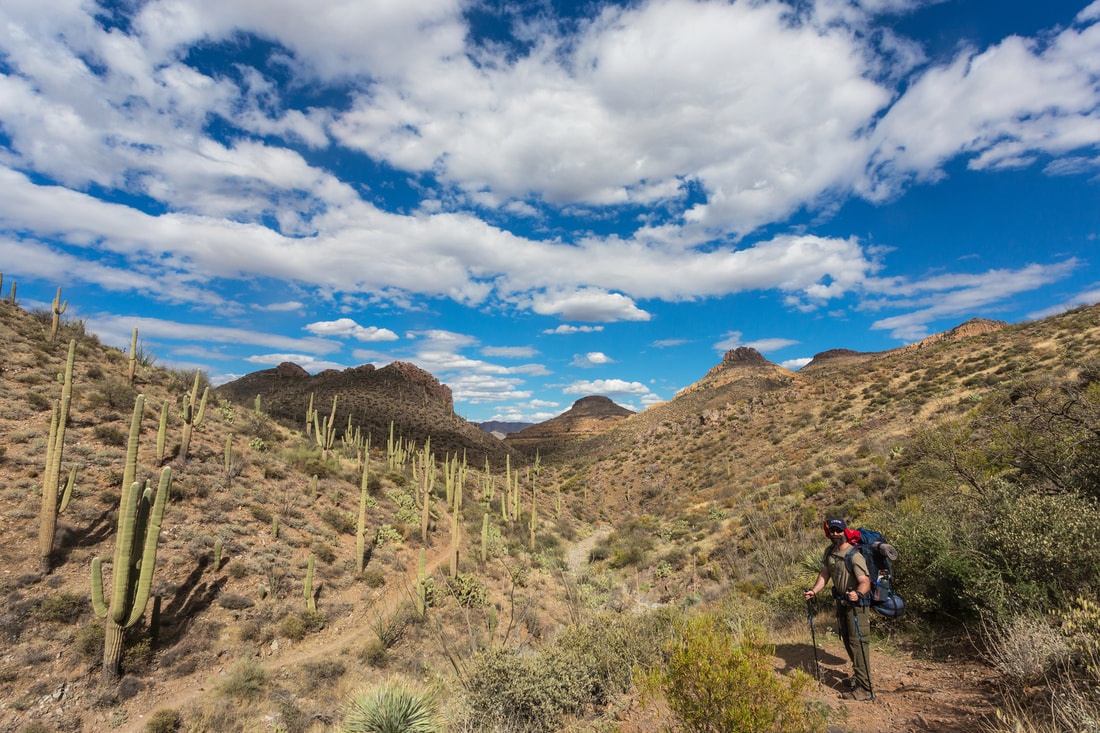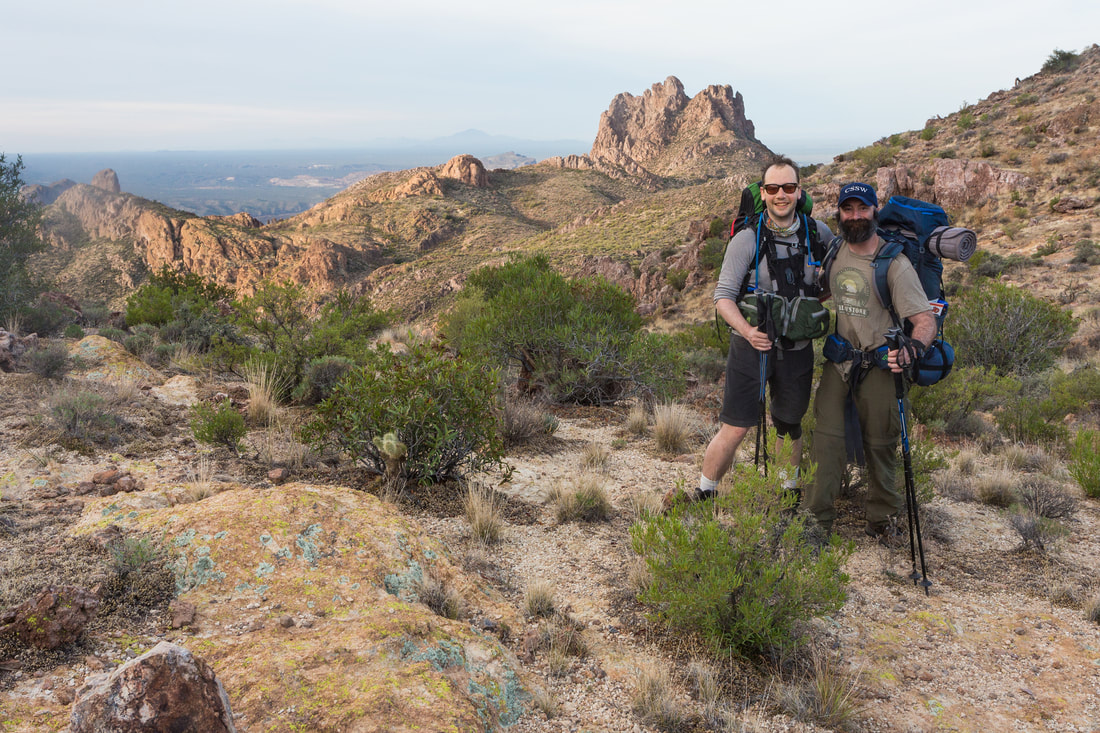 Hawkeye and I rose early the next morning. Our legs stiff with the desert’s chill and the previous day’s descent and climb. In the dark we fixed our oatmeal and our coffee. We stared in hard silence at the licks of blue flame from the stove while we waited for the water to boil. Dawn came over the mountains as we pulled on our packs. Though our limbs ached, our feet throbbed, we also felt rejuvenated and confident. We had water, plenty of water, at least for the day. And we knew we were close to the pinnacle of the week’s climb. Once we reached the top it would (mostly) be downhill. And it was easily the best day of the trip. At least for me. We climbed to the crest fairly easily and soon. The sky still had some streaks of plum and nectarines in the horizon, and the air was still cool and fresh with the sunrise. Looking out and across the desert lay a land untouched by man. The cliffs and the rocks rose out of the ground as twisted statues of forgotten and lonesome gods. We walked slowly and tried to breathe it all in. It wouldn’t be long before we’d be on a plane and back to our respected lives and jobs and all of it would just be memories. We didn't talk about it. But we knew we were both trying to remember every detail as best we could. The cacti, the rocks, the sapphire sky without end, even the pain in our feet. We found ourselves stopping a lot and gazing at the distance and listening to the silence, maybe the wind through the valley and nothing more. The day grew warm. We had several miles to go until we reached the next water spot, which was a water cache where people left jugs of water—some for themselves to find later, some donated by other hikers for people like Hawkeye and myself. I didn’t tell Hawkeye, but about two miles out I was out of water. I knew I would be okay, but I felt embarrassed for consuming it all after we’d gone through the dangers and the hassle of collecting water just the other day. My feet were killing me, but I tried to move quickly. I figured it was best to get to the water cache as soon as we could. When we crossed over the dry river bed and saw the brown iron box, we hesitated before opening the door. I think we were both afraid that we might open it to find it empty and then we’d be in trouble. But the cache was fully stocked with gallons and gallons of precious H2O. Hawkeye and I hugged each other in exhaustion. We set up a little shelter using a tarp to shade us from the sun and refilled our camelbacks. For lunch that day we ate beef jerky, salami, dried fruit, peanut butter on tortillas, and cliff bars. I took off my boots and let my feet breathe. As we sat there about five people came by on horseback. We said hello and they decided they’d have lunch there, too. One gentleman approached us and asked us what was with the iron box. “It’s water cache,” said Hawkeye. “People put jugs of water in there for anyone who comes along.” “You mean like Mexicans?” Hawkeye and I glanced at each other. “More like hikers like us probably.” “Are you guys packing?” Hawkeye and I noticed he had a snubbed nose .38 strapped to his hip. Having grown up in Arizona I was used to seeing people open carry, but I think Hawkeye was a little confused. “Nah,” I said. “Oh, man, I wouldn’t be out here without a firearm. You don’t know who you’ll run into.” The man started to tell us how undocumented workers wandered through the Tonto National Forrest on their journey from Mexico to Phoenix, but I stopped listening. I had met plenty of guys like him before. He had a thick New Jersey accent. He was riding a horse out in the desert without a hat. “Where are you guys riding from?” I said trying to change the subject. I wasn’t sure how close we were to Apache Junction, but we’d encountered other horseback riders from there. He shot me a look with a shrug. “From the parking lot! Where else? Idiot.” “Ah,” I said. When he and the others got back on their horses and rode away, we all waved and wished them well. As soon as they were out of sight I turned to Hawkeye and said, “Well, that guy sure was an asshole,” and we broke out laughing. TO BE CONTINUED
0 Comments
It was just after New Years that my buddy David “Hawkeye” Latham called me up and asked if I wanted to do a big backpacking trip. He’d been reading about the trails in Arizona, which is where I’m from. He said he wanted to see some saguaros with their arms stretched out like they were being robbed. January was shaping up to be a bad month, and I was losing my mind a bit. I needed something to look forward to. I needed to get away. I needed an adventure to shake me up. I was more than ready to hike back into the desert.
It took some planning. Lots of e-mails and phone calls. Lots of lists. But in mid-March we met up in Phoenix and headed east toward the Superstition Mountains. Having grown up in the Grand Canyon State, I knew that those mountains had a lot of bad mojo—lots of folks died in those hills. Some people went missing looking for treasure, others claimed to have seen giant Lizard People. Most of the men and women who never came back alive were the hikers who tried to walk across the desert in July and August with little water. Anyone who has read Urrea’s The Devil’s Highway will tell you that’s a bad idea. But March was wonderful for hiking the hills and valleys of the Sonoran desert. Never too hot, never too cold, and with a bit of color in the cactus flowers and a faint mist in the mornings. Our first few days went wonderfully. It stayed overcast and sprinkled a bit as we trekked in the mornings. We were miles away from everything. We followed the Gila River for miles before turning north and into the Tonto National Forrest where we wandered by steep cliffs and rugged paths of stone and sand. My legs and back were strong. David and I carried probably between forty and fifty pounds on our backs—maybe more. We aimed for roughly ten miles a day and kept a moderate pace. But it wasn’t long before my feet were killing me. I didn’t know my feet could hurt that bad. And then, as if being alone in the desert wasn’t enough, we ran into our one fear: We ran out of water. We’d finished the day’s hike without coming across any of the water spots on the map—or those spots had been dry as a barrel of dust. Latham and I sat down on the narrow trail and looked out across the valley and the scarred mountains around us. We caught our breath and talked out the scenario. We could abandon ship. We could try to press on and hope for the best, which was the most risky option. But Goonies never say die. We waited until dark. We got a little sleep but then, at 2:00 AM, we got up, emptied our packs in the brush by the trail and descended five miles back toward the Gila River. We took our Camelbacks and anything that might be able to hold water. Plastic bags, bottles, jugs, and cans. A person can go days without food. Water was more important. It wasn’t too bad a walk. It was cool in the early morning, our packs were now super light, and we were going downhill. We made it back to the river by the dawn. It took us a while to fill up everything. One of our water pumps broke on day one. But we were not in any rush. We sat by the cold rushing stream and filled everything we had with precious H2O. We rested and ate a simple breakfast of tortillas and dry salami. By the time we returned to our stuff at the top of the mountain we were exhausted from lack of sleep, adrenaline, and pushing ourselves to retreat and return through the desert. But we’d done it. We had plenty of water. That night we ate our freeze dried dinners and treated ourselves to scalding black coffee for desert. We slept under the stars ready for the gravy of the next day. TO BE CONTINUED |
Archives
September 2022
William JensenWriter living in Central Texas. Categories |


 RSS Feed
RSS Feed
